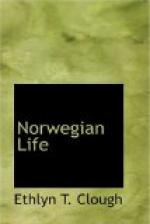In the period of about a dozen years following the death of Wergeland, the life, manners, and characteristics of the Norwegian people were given the especial attention of literary writers. Prominent in this period was Peter Christian Ashbjornsen (1812-1885), who, partly alone and partly in conjunction with Bishop Jorgen Moe (1813-1882), published some valuable collections of Norwegian folk tales and fairy tales. Moe also published three little volumes of graceful and attractive poems. Among other writers of this period may be named Hans H. Schultz, N. Ostgaard, Harald Meltzer, M.B. Landstad, and the linguist Sophus Bugge.
The efforts to bring out the national life and characteristics of the people in literature also led to an attempt to nationalize the language in which the literature was written. The movement was the so-called Maalstraev, and had in view the introduction of a pure Norwegian book language, based upon the peasant dialects. The prominent supporter of this movement was Ivar Aasen (1813-1898), the author of an excellent dictionary of the Norwegian language. A prominent poetical representative of this school was Aasmund Olafson Vinje (1818-1870), while Kristofer Janson (born 1841) has also written a number of stories and poems in the Landsmaal (country tongue).
A new and grand period in Norwegian literature commenced about 1857, and the two most conspicuous names in this period—and in the whole Norwegian literature—are those of Henrik Ibsen and Bjoernstjerne Bjoernson.
Henrik Ibsen was born in Skien, in 1828. He has written many beautiful poems; but his special field is in the drama, where he is a master. His first works were nearly all historical romantic dramas. His first work, Catilina, printed in 1850, was scarcely noticed until years afterward, when he had become famous. In 1856 appeared the romantic drama, Gildet paa Solhaug, “The Feast at Solhaug,” followed by Fru Inger til Oestraat, 1857, and Haermaedene paa Helgeland, “The Warriors on Helgeland,” 1858. In 1863, he wrote the historical tragedy Kongsemnerne, “The Pretenders,” in which the author showed his great literary power. Before this play was published, he had been drawn into a new channel. In 1862, he began a series of satirical and philosophical dramas with Kjaerlighedens Komedie, “Love’s Comedy,” which was succeeded by two masterpieces of a similar kind, Brand, in 1866, and Peer Gynt, in 1867. These two works were written in verse; but in De Unges Forbund, “The Young Men’s League,” 1869, a political satire, he abandoned verse, and all his subsequent dramas have been written in prose. In 1873 came Keiser og Galilaeer, “Emperor and Galilean.” Since then he has published a number of social dramas which have attracted world-wide attention. Among them are: Samfundets Stoetter, “The Pillars of Society,” Et Dukkehjem, “A Doll’s House,” Gengangere, “Ghosts,” En Folkefiende, “An Enemy of the People,” Rosmerholm, Fruenn fra Havet, “The Lady from the Sea,” Little Eyolf, Bymester Solnes, “Masterbuilder Solnes,” John Gabriel Borkman, and the latest and most-talked-about, Hedda Gabler.




